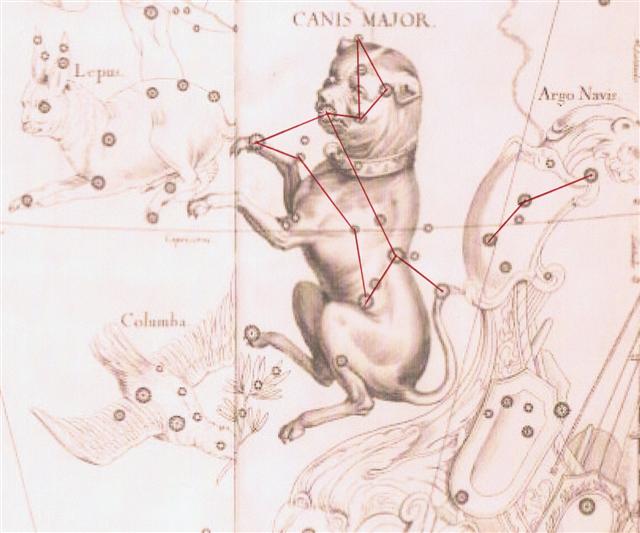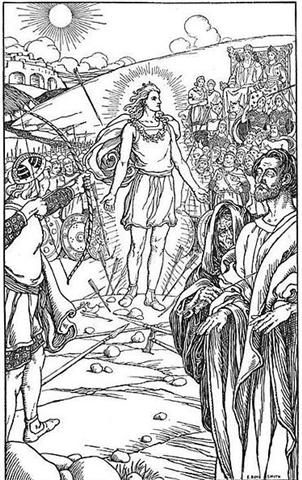In the nakshatra night following the heliacal rising of Vega the greatest of all the fixed stars, Sirius, was close to the full moon and 3 days later it was the time of Alhena (γ Gemini), it was January 1 and Ain al Rami (ν Sagittarii) was close (also in declination) to Sun:
RA day 243 (November 19, at mauga pu in Ca9-15) + 40 = 283 and 80 + 283 = 363 (December 29), the night when Moon will join Sirius. When Sirius was close to Moon in the nakshatra night it was known Sun had passed the 40 days ending with 'playing the harp' up at Vega. In December 23 κ Lyrae had risen with the Sun, as the first of the stars in the Lyra constellation - time had to be reversed in Lyra because Sun was here moving 'down below the earth'. Its 'clockwork had to be redrawn' in order for Sun to rise again in the east next 'morning'. In January 1 (Ca11-2) there were not 3 'fingers' ahead (as in Taurus) but 3 mata (in front of the inoino sign). There are 45 nights from kava with 3 mata ahead (Ca9-13) to January 1. But maybe we should count 46 days from Menkhib (ζ Persei), the first of my listed stars to rise after the Pleiades:
Or perhaps we should rather say that the counting is beginnig with Sheratan 1, when there was no listed star close to the full moon - a 'zero' night. Ca9-11 is 27 days later than a similar marama glyph in Ca8-13 (212). The mauga has closed its hole in Ca11-9 (where 11 * 9 = 99 = 100 - 1). We cannot ignore such 'reflections' as 9-11 (239) compared with 11-9 (293):
293 (January 8) - 239 (Sheratan 1) = 54. If Sheratan 1 is counted as a 'zero-day' then Heka 2 will be number 54. Alrami is α Sagittarii and on the same (front left) leg of the Archer is the pair Arkab Prior (β¹) and Arkab Posterior (β²). I suspect the little henua sign in front in Ca11-9 could represent the other leg (the right front one) of the Archer, the leg which according to Hevelius is cut off from sight by the upside down Southern Crown. If so, then Aludra (η Canis Majoris, the last of my listed stars in the constellation) ought to have something to do with this 'severed' leg.
July 1 (182) = Al Tuwaibe' 6 (46) is 182 days earlier than December 30 (364) = Qalb al Akraab 6 (228). In July 3 (184) when in the night the observer saw Alhena (γ Gemini, at the left foot of Pollux) he knew Sun was at Ain al Rami ('Eye of the Archer', ν Sagittarii, close to the ecliptic, already by Ptolemy recognized as a 'nebulous pair'). Gamma both in Gemini and in Sagittarius.
The RA day for Alhena was 104, and 104 (= 4 * 26) + 182 (= 7 * 26) = 11 * 26 (= 286). This was January 1 (1-1, and eleven means 'one more' than 10).
19h / 24h * 365.25 = 289.2 and in this night (January 4) Wezen (δ
Canis Majoris, at the backbone of the Great Dog)
was close to the Full Moon.
Possibly Hevelius was inspired by Sirius as the nose of the Great Dog when he decided to put Ain al Rami at the 'nose' of the Archer. Wezen could have been important. RA day 107 was July 6 (187) and 181 days before January 3 (368). In my earlier table Nunki has been given as its nakshatra star:
However, when the full moon was close to Wezen it should also have been known Sun was at Manubrium (ο Sagittarii). 107 = 80 + 27 = April 17 when Polaris and Sheratan rose heliacally. 107 + 183 = 290 (October 17) is half the sky away. But I guess we should rather count 289 (October 16) - 182 = 107, because this seems to have corresponded to Orongo:
RA day 290 is later. In January 5 (735) = manzil day 599, when Sun was at Al Baldah (π Sagittarii), a star at the neck (at the top of the backbone of the of the Archer):
The kava glyph in the following day seems well motivated. Wasat (δ Canis Majoris) would soon (in Heka 1) be seen close to Moon and Sun would be in manzil day 236, a number probably associated with 'turning upside down' as we know from the G text. Alrami (α Sagittarii, at his left leg) would then follow the upside down Southern Crown. This could be concluded from observing Moon close to the last star of (in the tail of) Canis Major, Wasat (η). It was a blind god who was tricked to kill Balder. Presumably he was blind because it was a Sign of winter time when Sun (light) was absent. Therefore this blind god could have been a 'personification' of the Archer (Sagittarius) who in the night released his arrow. Balder could have represented the other (front) side of the sky. ... the interpretation of Baldr as 'the brave god' may be secondary. Baltic (cf. Lithuanian baltas, Latvian balts) has a word meaning 'the white, the good', and Grimm speculates that the name may originate as a Baltic loan into Proto-Germanic. In continental Saxon and Anglo-Saxon tradition, the son of Woden is called not Bealdor but Baldag (Sax.) and Bældæg, Beldeg (AS.), which shows association with 'day', possibly with Day personified as a deity which, Grimm points out, would agree with the meaning 'shining one, white one, a god' ... ... He had a dream of his own death and his mother had the same dream. Since dreams were usually prophetic, this depressed him, so his mother Frigg made every object on earth vow never to hurt Baldr. All objects made this vow except mistletoe. Frigg had thought it too unimportant and nonthreatening to bother asking it to make the vow (alternatively, it seemed too young to swear). When Loki, the mischief-maker, heard of this, he made a magical spear from this plant (in some later versions, an arrow). He hurried to the place where the gods were indulging in their new pastime of hurling objects at Baldr, which would bounce off without harming him. Loki gave the spear to Baldr's brother, the blind god Höðr, who then inadvertently killed his brother with it (other versions suggest that Loki guided the arrow himself).
For this act, Odin and the giantess Rindr gave birth to Váli who grew to adulthood within a day and slew Höðr ... ... 'The earth rises up from the sea again, and is green and beautiful and things grow without sowing. Vidar and Vali are alive, for neither the sea nor the flames of Surt have hurt them and they dwell on the Eddyfield, where once stood Asgard. There come also the sons of Thor, Modi and Magni, and bring along his hammer. There come also Balder and Hoder from the other world. All sit down and converse together. They rehearse their runes and talk of events of old days. Then they find in the grass the golden tablets that the Aesir once played with. Two children of men will also be found safe from the great flames of Surt. Their names, Lif and Lifthrasir, and they feed on the morning dew and from this human pair will come a great population which will fill the earth. And strange to say, the sun, before being devoured by Fenrir, will have borne a daughter, no less beautiful and going the same ways as her mother.' They were brothers, Balder and Höder, possibly twins, and if Höder was Sagittarius then Balder ought to be at the other end of the sky. If Sagittarius was α (Alrami), then we can try to count January 8 (373) - 182 = 191 (July 10). But RA day 290, only 4 days earlier, was the position of his brother (Al Baldah). July 7 (188) - 182 = January 6 appears to be more in harmony with the C text. Balder (Al Baldah, π Sagittarii) may have lived from his heliacal rising (birth) in January 5 up to and including July 8, i.e. for 185 nights. July 9 = Heka 1. His brother Höder (Alrami, α) may then have lived from his nakshatra date July 10 (191) up to and including January 4. 369 - 190 = 179. 185 + 179 = 364. Within a day after Váli's birth he slew Höder. This part of the myth could possibly explain why there is one day misssing, why Höder did not live for 180 days. In a system which used both heliacal (Sun) and nakshatra (Moon) dates it would not be strange if Al Baldah was born in January 5 and 3 days earlier than his twin brother Alrami who was born in July 10. | ||||||||||||||||||||||||||||||||||||||||||||||||||||||||||||||||||||||||||||||||||||||||||||||||||||||||||||||||||||||||||||||||||||||||||||||||||||||||||||||||||||||||||||||||||||||||||||||||||||||||||||||









